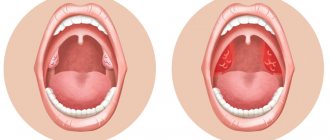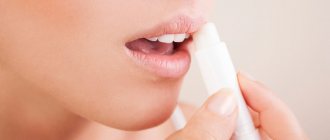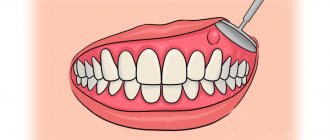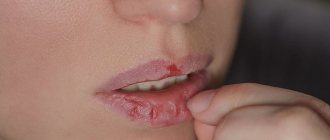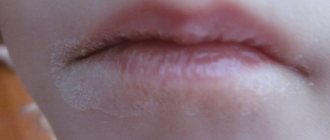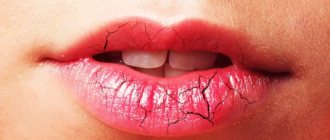Dermatovenerologist
Khasanova
Alina Rashidovna
9 years experience
Make an appointment
Patients often consult a doctor complaining of inflammation in the red border or mucous membrane of the lips. In most cases, a specialist diagnoses “cheilitis”. This is the name for tissue inflammation, which manifests itself in the form of redness, peeling, the appearance of purulent crusts and weeping ulcers. Any attempt to open the mouth when eating or communicating causes sharp pain associated with tissue damage. Without proper treatment, the disease persists for a long time, causing the patient a lot of physical and aesthetic inconvenience. For young people, the prognosis after clinical treatment of cheilitis is completely favorable, but older patients may encounter its complications in the form of leukoplakia and the onset of the oncological process.
What it is
Chronic damage to the red border of the lips, in which peeling and irritation does not spread to the surrounding tissues, is called exfoliative cheilitis. Women of childbearing age are most susceptible to this disease.
Doctors distinguish two forms of exfoliative cheilitis:
- The dry form is accompanied by chronic dry lips, peeling, and sometimes itching and burning. Often, hyperemia begins between the mucous and red border, resulting in the formation of a dense strip consisting of transparent scales at this border. When this layer is surgically removed, the unprotected surface of the rich red mucosa is exposed. Most often it is smooth to the touch, but it may develop shallow ulcerations or bumps.
- The exudative form differs from the dry form by sharply enlarged, swollen, hyperemic lips. The patient cannot close his mouth completely due to pain, as a result of which his lips are constantly parted. This form of exfoliative cheilitis got its name due to the constant release of exudate, which gradually dries out and forms massive crusts. In most cases, they are quite easy to remove, but sometimes the exudate and scales can grow together, forming a continuous layer hanging down to the chin.
Not all patients believe that the dry form requires treatment in the same way as the exudative one, as a result of which the disease quickly becomes chronic and can last for many years. In addition, both forms of the disease can transform into one another, but very rarely spontaneous recovery occurs. Some people mistakenly consider this type of disease to be precancerous.
Symptoms and signs depending on the type of cheilitis
The accepted classification of cheilitis makes it possible to clearly establish the type and causes of the disease, as well as to identify the characteristic signs of the pathological process:
- Exfoliative cheilitis is localized on the red border of the lips. It has a clear gender link: it occurs more often in women. The main symptom is peeling of the lips due to neurological disorders: stress, depression, anxiety. Often the inflammatory process develops against the background of hyperthyroidism, or intense activity of the thyroid gland. The danger of exfoliative cheilitis is its ability to be inherited as a genetically fixed change in the body’s immune system.
A feature of exfoliative cheilitis is localization only on the red border of the lips, while the mucous membrane and skin around the mouth remain intact. In most cases, only part of the border is affected, while areas at the corners of the mouth usually retain their appearance. If a patient has dry skin, he often complains of tightness of the lips, the appearance of scales, and a burning sensation. It is almost impossible to completely cure exfoliative cheilitis. The disease proceeds along a sinusoid, sometimes exacerbating, sometimes disappearing under the influence of medications and external factors. Without medical supervision and if you refuse to take a course of treatment, large bleeding crusts form on the lips, which cause discomfort during conversation and eating.
- Glandular cheilitis develops against the background of pathological proliferation of the salivary glands. A humid environment creates favorable conditions for pathogenic microorganisms, as a result of which the mucous membrane becomes easily infected. If the pathology of the salivary glands is congenital, the probability of developing glandular cheilitis is 100%. The risk group also includes patients with dental problems: untreated caries, periodontitis, tartar, etc.
In some cases, glandular cheilitis develops as a result of damage from waste products and the breakdown of pathogenic microorganisms. The disease is more often diagnosed in patients over 30 years of age and is localized on the lower lip. Primary symptoms are dry lips and the appearance of painful cracks. Usually these symptoms are ignored, and attempts are made to combat them with local cosmetic products. Without treatment, the problem worsens: erosions and bleeding wounds appear at the site of cracks. Involuntary licking of dry lips aggravates the pathological process, which leads to their further dryness.
- Contact allergic cheilitis is caused by exposure to an external allergen. This could be the chemical composition of lipstick, microorganisms on the surface of pencils or pens, which the patient is accustomed to often holding in his teeth during work or creative activities. Cheilitis is considered an occupational disease among musicians who are forced to hold the mouthpieces of instruments in their mouths for a long time. The symptoms of this type of pathology are quite common. Patients complain of itching, swelling, burning and inflammation of the lips. After prolonged contact with the allergen, blisters appear on the skin, the rupture of which opens small ulcers and erosions. In the chronic stage, the disease makes itself felt only with minor itching and peeling.
- Meteorological or actinic cheilitis is a reaction to weather conditions. For a sensitive organism, radiation, wind, cold or solar radiation are equally dangerous, provoking the appearance of characteristic symptoms: burning and itching, large crusts and erosion of the mucous membrane. With prolonged exposure to unfavorable climatic factors, the formation of small bubbles with liquid contents is possible. The dry form of cheilitis is considered the most dangerous for patients. Its first symptoms in the form of itching and burning are harmless. However, with prolonged development and lack of treatment, malignancy is possible - the degeneration of affected cells into a malignant formation.
- Atopic cheilitis is a type of skin disease: atopic dermatitis and neurodermatitis. The disease develops against the background of an allergic predisposition of the body, which reacts to cosmetics, perfumes, food and exposure to pathogenic bacteria. In addition to the usual symptoms, there is dryness and damage to the skin in the corners of the mouth, and intense peeling of the face.
- Hypovitaminous cheilitis develops against the background of a lack of B vitamins in the body. Patients usually complain of dryness and burning of the tongue and lips. Vertical cracks and small peeling scales are visible on the skin. The tongue increases in size, and teeth marks become visible on it.
Are you experiencing symptoms of cheilitis?
Only a doctor can accurately diagnose the disease. Don't delay your consultation - call
Causes
According to research results, the main cause of the development of exfoliative cheilitis is a disruption of the central nervous system, accompanied by depression, nervous exhaustion, apathy, phobias and other psychosomatic reactions. In addition, some doctors share the view that genetic abnormalities and systemic allergic reactions are involved in the development of this disease. The possibility of a sharp decrease in immunity cannot be ruled out.
In some patients, this type of cheilitis occurs due to problems with the thyroid gland. Another suspected reason is an increase in the permeability of capillary walls. However, the pathogenesis and etiology of exfoliative cheilitis are still not fully understood.
Treatment results
Under the influence of the therapy, it was possible to achieve regression of AC symptoms in most patients, while improving skin trophism. The topical glucocorticosteroids used quickly stopped the exacerbation of AC.
The children were under observation throughout the treatment period. The result of therapy was assessed as good when all symptoms of AC disappeared or were significantly weakened; as satisfactory – with slight improvement; as negative – in the absence of treatment effect. A good effect from treatment with external therapy was achieved by 62 (62%) patients, a satisfactory effect by 31 (31%), and no effect was observed in 7 (7%) children.
Thus, when treated with the external therapy presented above, the majority of children with AC managed to reduce hyperemia, peeling of the KKG and skin of the perioral area, as well as ensure a decrease in skin lichenification and healing of cracks.
Clinical improvement of the atopic process on the lips during treatment with external agents occurred on the 2-3rd day of treatment. The dynamics of clinical manifestations of AC during therapy are presented in the figure.
The duration of remission of the isolated form of AC was on average 4–6 months, and remission of AC against the background of AD was 2–3 months.
The dentist should consider the symptoms of AC, perioral dermatitis, and cracked oral commissures in children as possible manifestations of an allergic process. It is necessary to recommend that parents contact a pediatrician and allergist to have their child examined.
Symptoms
The main signs of exfoliative cheilitis are dryness, flaking and itching that do not extend beyond the red line of the lips. The mucous membrane of the oral cavity, the corners of the lips and the skin around them are not affected. The main manifestation of the dry form is the formation of scales, which the patient most often simply bites off, not attaching importance to the disease and without consulting a doctor. After removing the scales, a red, hyperemic surface remains, on which scales form again within a week.
In the exudative form, the symptoms are characterized by the presence of pain, the formation of gray and brownish crusts of scales and dried exudate, which complicate eating and communication.
Treatment of various types of cheilitis
The course is developed taking into account the type of diagnosed disease and the general condition of the body.
- For exfoliative cheilitis, additional consultations with a neurologist and neuropsychiatrist are recommended. The patient is prescribed a course of sedatives. Effective methods of local treatment include laser therapy, ultrasound or radiation therapy, and the use of moisturizing cosmetic creams and ointments. According to indications, hormonal medications and vitamin complexes are prescribed.
- Glandular cheilitis is removed with anti-inflammatory ointments. Local treatment consists of cauterization or desquamation of enlarged salivary glands, and during the rehabilitation period, the use of drugs to eliminate dryness or excess moisture of the mucous membrane.
- When treating atopic cheilitis, the goal is to eliminate any irritating factors. The local course is based on the use of anti-inflammatory and anti-allergic drugs in the form of external ointments. Patients are also recommended to have a hypoallergenic diet that excludes the consumption of fish, citrus fruits, spicy foods and alcohol.
- For meteorological cheilitis, treatment tactics include taking vitamin preparations, using local healing agents and ointments with a high UV filter.
Timely initiation of treatment and the patient completing its full course guarantees relief from the unpleasant symptoms of cheilitis with a long-term effect.
Diagnostics
To make a correct diagnosis, the doctor must be able to distinguish the manifestations of exfoliative cheilitis from other types (eczematous, actinic, contact, atopic), as well as from the symptomatic picture of lupus erythematosus. Unlike all of the listed diseases, this type of lesion is not accompanied by the formation of blisters, erosions, cracks, scars and other lesions, with the exception of those listed above, and does not spread beyond a certain part of the red border of the lips. The transition of this type of cheilitis to others is also not noted; only an internal transition from one form to another is possible.
How the problem manifests itself
HC “announces itself” with classic symptoms - characteristic red dots appear on the border of the lips (seen in the photo above). These are nothing more than the mouths of the salivary glands affected by the disease. If you blot your lips, after a short period of time droplets of secretion will appear on them again. Due to the fact that saliva is produced in excess of normal, the surface of the lips is constantly moisturized. But due to the constant evaporation of liquid, the skin, accustomed to “humidity,” cracks and flakes.
Secondary GC is a complication of skin diseases, pathological processes in the oral cavity, the result of smoking and neglect of the rules of caring for teeth and gums
In some patients, the course of HC is associated with constant itching in the affected area. At the same time, the “affected” skin looks rough, unhealthy, the epithelium becomes keratinized and dry. White ring-shaped formations often appear around the mouths of the salivary glands - these are foci of leukoplakia. The purulent form of cheilitis most typically manifests itself. Thus, the lips swell, become extremely sensitive to any mechanical damage, and are very painful.
On examination, the skin looks red, swollen, thinned, flaky, the epithelium is covered with multiple purulent crusts. Upon palpation, enlarged, compacted salivary glands are determined, when pressed, a secretion mixed with purulent exudate is released. In the complicated course of Volkmann's cheilitis, local signs of inflammation are accompanied by symptoms of general intoxication of the body, enlargement of the submandibular lymph nodes, and abscess formation of the lips.
Treatment
If you are diagnosed with exfoliative cheilitis, treatment should be comprehensive. The prescription of drugs will depend directly on the probable cause of the disease. The psycho-emotional cause involves treatment with antipsychotics, antidepressants and even tranquilizers. In addition, the patient needs to seek professional help from a neuropsychiatrist.
To eliminate scales, crusts and itching, it is recommended to constantly lubricate your lips with oil solutions, creams or hygienic lipstick. If you have other symptoms (dizziness, lump in the throat, shaking hands, dry mouth), it is recommended to get tested for thyroid hormones and begin appropriate treatment.
Among other things, immunocorrection and the use of vitamin-mineral complexes would be useful. In difficult cases, the doctor may prescribe local administration of hormonal drugs through ultrasound or laser therapy. With long-term treatment, the exudative form can turn into dry.
Treatment of exfoliative cheilitis
Treatment of exfoliative cheilitis involves, first of all, influencing the factors that provoked it. Since cheilitis is one of the diseases associated with the patient’s psycho-emotional state, a consultation with a neurologist is often required, who can prescribe sedatives or antidepressants. If the disease occurs due to thyroid dysfunction, you will need to consult an endocrinologist.
Treatment may also include acupuncture, removal of keratinized crusts on the lips with a solution of boric acid, and in children, the use of a moisturizer.
The disease is not prone to self-healing, so it is necessary to find the cause of the disease and carry out all treatment measures in a timely manner.
Prevention
Since it is impossible to predict the development of exfoliative cheilitis, the only means of prevention will be oral hygiene, proper nutrition, a healthy lifestyle, giving up bad habits and taking a course of vitamins in the autumn-winter period. It is necessary to carefully monitor the immune system and take timely measures to restore it. Also, do not overuse lipsticks containing lanolin, as it clogs pores, dries out lips and often causes an allergic reaction.
Reasons for the development of cheilitis
Factors that can lead to the development of cheilitis include:
- dermatoses (erythematoses, tuberculosis, psoriasis, syphilis and other skin diseases);
- unfavorable weather and climatic conditions (the influence of too hot or cold air, excessive insolation, strong wind);
- prolonged work outdoors;
- sensitization of epithelial tissues of the lips by UV radiation, chemicals and other allergens;
- neuritis of the facial nerve.
Eczematous cheilitis
Eczematous cheilitis manifests itself under the influence of allergic factors. Most often it happens for cosmetics. Predisposing factors include chronic lip injury and a lack of B vitamins.
Manifestations: Congestive hyperemia, infiltration, the presence of fever-like elements are observed, and seizures may also occur in the corners of the mouth. The lips are covered with crusts. The skin around the lips also suffers, it becomes wet, it peels and burns.
Treatment: All treatment is based on antiseptic treatment of the lips, taking multivitamins, as well as the use of corticosteroid ointments. And first of all, it is natural to eliminate unfavorable factors, that is, the causes.
